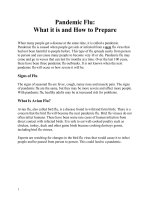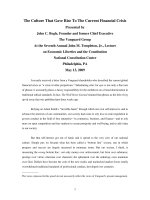Tài liệu The Dynamic Model_ An Introduction to UML pdf
Bạn đang xem bản rút gọn của tài liệu. Xem và tải ngay bản đầy đủ của tài liệu tại đây (53.72 KB, 10 trang )
Enterprise Architect
An introduction to modelling software systems using
the Unified Modelling Language:
The Dynamic Model
UML Case Tool by Sparx Systems
© Geoffrey Sparks 2001 Page:1
An Introduction to UML
The Dynamic
Model
by Geoffrey Sparks
All material (c) Geoffrey Sparks 2001
www.sparxsystems.com.au
Enterprise Architect
An introduction to modelling software systems using
the Unified Modelling Language:
The Dynamic Model
UML Case Tool by Sparx Systems
© Geoffrey Sparks 2001 Page:2
Table of Contents
THE DYNAMIC MODEL .................................................................................................................... 3
I
NTRODUCTION TO
UML...................................................................................................................... 3
S
EQUENCE
D
IAGRAMS
.......................................................................................................................... 3
Purpose ........................................................................................................................................... 3
Notation........................................................................................................................................... 3
A
CTIVITY
D
IAGRAMS
........................................................................................................................... 5
Purpose ........................................................................................................................................... 5
Notation........................................................................................................................................... 5
S
TATE
C
HARTS
..................................................................................................................................... 8
Purpose ........................................................................................................................................... 8
Example Notation............................................................................................................................ 8
S
UMMARY
............................................................................................................................................ 9
RECOMMENDED READING........................................................................................................... 10
Enterprise Architect
An introduction to modelling software systems using
the Unified Modelling Language:
The Dynamic Model
UML Case Tool by Sparx Systems
© Geoffrey Sparks 2001 Page:3
The Dynamic Model
This paper describes how to model the dynamic aspects of software systems using
UML notation and semantics. The three topics covered are sequence diagrams, activity
diagrams and state charts. An explanation is given of each and how they fit into the
overall model structure.
Introduction to UML
The Unified Modelling Language (UML) is, as its name implies, a modelling language
and not a method or process. UML is made up of a very specific notation and the
related grammatical rules for constructing software models. UML in itself does not
proscribe or advise on how to use that notation in a software development process or as
part of an object-oriented design methodology.
This paper focuses on the modelling of dynamic behaviour using UML notation and
semantics. Dynamic interaction and behaviour in UML is broken down into three main
categories:
1. Interactions between object instances at run-time. This is modelled using Sequence
diagram and/or Collaboration diagrams. This paper will only discuss Sequence
diagrams, as Collaboration and Sequence diagrams are semantically identical.
2. General activity descriptions covering business process and user interaction.
Activity diagrams and Business Process diagrams are used for this purpose.
3. State changes over time. UML supports State charts for modelling state changes.
You can find out more about UML from the books mentioned in the suggested reading
section and from the UML specification documents to be found at the Object
Management Groups UML resource pages: and
at />Sequence Diagrams
Purpose
Sequence diagrams are used to display the interaction between users, screens and
object instances within the system. They provide a sequential map of message passing
between objects over time. Frequently these diagrams are placed under Use Cases or
Components in the model to illustrate a scenario, or common set of steps followed in
response to an event that generates an outcome. The model includes what initiates
activity in the system, what processing and changes occur internally and what outputs
are generated. Often, the object instances are represented using special stereotyped
icons - icons exist for boundary objects, controllers and persistent entities.
Notation
The notation used is typically a horizontally deployed set of actors and object instances,
each having a vertical lifespan bar. Messages (usually method calls but may also
Enterprise Architect
An introduction to modelling software systems using
the Unified Modelling Language:
The Dynamic Model
UML Case Tool by Sparx Systems
© Geoffrey Sparks 2001 Page:4
represent messages passed using message queuing services and other events) are drawn
from one object to another with an arrow indicating the direction of flow.
A Sequence diagram is representation of the messages passed between object instances,
so generally the messages will map during the design phase of the project to class
operations. The initial Sequence diagrams indicate what public behaviour is needed for
objects to get work done and cooperate, and during design, Sequence diagrams are sued
to show what actual responsibilities and operations are assigned to which classes.
The example diagram below demonstrates some features of Sequence diagrams
Customer Login Screen SecurityManager
: Security
Controller
Users :
Customer
A customer will be required to login in to the book store prior to browsing and making selections.
Arrows between
components represent
the flow of information
and requests for
services between users
and components
A message to
self
Login
GetDocument
ValidateCustomer
[UserDetails]
Validate
[Result]
GetName
Note the use of stereotyped icons to display particular objects: for example the user
interface (Login Screen) is displayed with a Boundary strereotype and the User as an
Entity stereotype. These help visually differentiate object roles during analyis.
Enterprise Architect
An introduction to modelling software systems using
the Unified Modelling Language:
The Dynamic Model
UML Case Tool by Sparx Systems
© Geoffrey Sparks 2001 Page:5
Activity Diagrams
Purpose
Activity diagrams are used to show how different work flows or processes in a system
are constructed, how they start, the many decision paths that can be taken from start to
finish and where parallel processing may occur during execution.
An Activity diagram generally does not model the exact internal behaviour of a
software system (like a Sequence diagram does) but rather it shows the general
processes and pathways at a high level. Often it is used to model business activities
(such as Selling Books or Manage Inventory), and may be at a very high level.
Activities will generally be realised by one or more Use Cases, the Activity describes
the process that is undertaken and the Use Case how an Actor will use the system to
realise all or part of an Activity.
Notation
Activity Diagram Notation
Standard UML notation uses a rectangle with rounded corners to depict an Activity.
Activities may be joined by process flows or events. In addition, a Decision node can
model divergent behaviour based on a condition. Typically a Start and End node are
defined to complete the full Activity representation. Synchronisation points may also
be defined to illustrate how processing may be carried out in parallel, then
synchronised at a point before further activity is undertaken.
The example below illustrates most of these points – it describes the process
surrounding the acquiring of a beverage from a vending machine. The rounded
rectangles are Activities, the diamonds are Decision points and the horizontal black
bars are synchronisation points.
Note that if you were building drink vending machine software, only some of the
activities are relevant, although the diagram as a whole provides a good picture of what
the total process of getting a beverage is all about. Further analysis would be needed to
determine which parts of this model could be implemented or supported in software.









